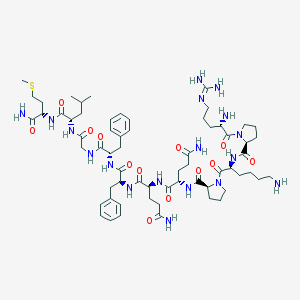

You can:
| Name | Substance P |
|---|---|
| Molecular formula | C63H98N18O13S |
| IUPAC name | (2S)-2-[[(2S)-1-[(2S)-6-amino-2-[[(2S)-1-[(2S)-2-amino-5-(diaminomethylideneamino)pentanoyl]pyrrolidine-2-carbonyl]amino]hexanoyl]pyrrolidine-2-carbonyl]amino]-N-[(2S)-5-amino-1-[[(2S)-1-[[(2S)-1-[[2-[[(2S)-1-[[(2S)-1-amino-4-methylsulfanyl-1-oxobutan-2-yl]amino]-4-methyl-1-oxopentan-2-yl]amino]-2-oxoethyl]amino]-1-oxo-3-phenylpropan-2-yl]amino]-1-oxo-3-phenylpropan-2-yl]amino]-1,5-dioxopentan-2-yl]pentanediamide |
| Molecular weight | 1347.65 |
| Hydrogen bond acceptor | 17 |
| Hydrogen bond donor | 15 |
| XlogP | -2.3 |
| Synonyms | Arg-Pro-Lys-Pro-Gln-Gln-Phe-Phe-Gly-Leu-Met NH2 CCRIS 7229 H-Arg-Pro-Lys-Pro-Gln-Gln-Phe-Phe-Gly-Leu-Met-NH2(Substance P) 675VGV5J1D Arg-Pro-Lys-Pro-Gln-Gln-Phe-Phe-Gly-Leu-Met-NH2(substance P) [ Show all ] |
| Inchi Key | ADNPLDHMAVUMIW-CUZNLEPHSA-N |
| Inchi ID | InChI=1S/C63H98N18O13S/c1-37(2)33-45(57(89)74-41(53(68)85)27-32-95-3)73-52(84)36-72-54(86)46(34-38-15-6-4-7-16-38)78-58(90)47(35-39-17-8-5-9-18-39)79-56(88)42(23-25-50(66)82)75-55(87)43(24-26-51(67)83)76-59(91)49-22-14-31-81(49)62(94)44(20-10-11-28-64)77-60(92)48-21-13-30-80(48)61(93)40(65)19-12-29-71-63(69)70/h4-9,15-18,37,40-49H,10-14,19-36,64-65H2,1-3H3,(H2,66,82)(H2,67,83)(H2,68,85)(H,72,86)(H,73,84)(H,74,89)(H,75,87)(H,76,91)(H,77,92)(H,78,90)(H,79,88)(H4,69,70,71)/t40-,41-,42-,43-,44-,45-,46-,47-,48-,49-/m0/s1 |
| PubChem CID | 36511 |
| ChEMBL | CHEMBL235363 |
| IUPHAR | 2098 |
| BindingDB | 50001450 |
| DrugBank | N/A |
Structure |  |
| Lipinski's druglikeness | This ligand has more than 5 hydrogen bond donor. This ligand has more than 10 hydrogen bond acceptor. This ligand is heavier than 500 daltons. |
You can:
| GLASS ID | Name | UniProt | Gene | Species | Length |
|---|---|---|---|---|---|
| 521522 | Mas-related G-protein coupled receptor member X2 | Q96LB1 | MRGPRX2 | Homo sapiens (Human) | 330 |
| 2490 | Neuromedin-K receptor | P29371 | TACR3 | Homo sapiens (Human) | 465 |
| 2496 | Neuromedin-K receptor | P16177 | Tacr3 | Rattus norvegicus (Rat) | 452 |
| 2498 | Neuromedin-K receptor | P30098 | TACR3 | Cavia porcellus (Guinea pig) | 440 |
| 553258 | Neuromedin-K receptor | P47937 | Tacr3 | Mus musculus (Mouse) | 452 |
| 2489 | Substance-K receptor | P51144 | TACR2 | Mesocricetus auratus (Golden hamster) | 384 |
| 2491 | Substance-K receptor | P16610 | Tacr2 | Rattus norvegicus (Rat) | 390 |
| 2494 | Substance-K receptor | Q64077 | TACR2 | Cavia porcellus (Guinea pig) | 402 |
| 2495 | Substance-K receptor | P21452 | TACR2 | Homo sapiens (Human) | 398 |
| 2487 | Substance-P receptor | P14600 | Tacr1 | Rattus norvegicus (Rat) | 407 |
| 2488 | Substance-P receptor | P25103 | TACR1 | Homo sapiens (Human) | 407 |
| 2492 | Substance-P receptor | P30547 | TACR1 | Cavia porcellus (Guinea pig) | 407 |
zhanglab![]() zhanggroup.org | +65-6601-1241 | Computing 1, 13 Computing Drive, Singapore 117417
zhanggroup.org | +65-6601-1241 | Computing 1, 13 Computing Drive, Singapore 117417